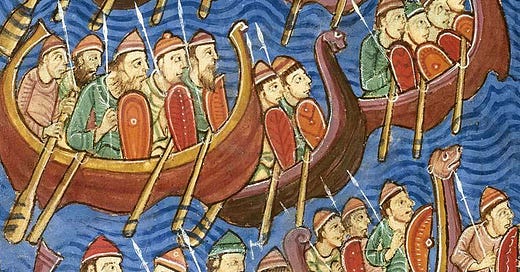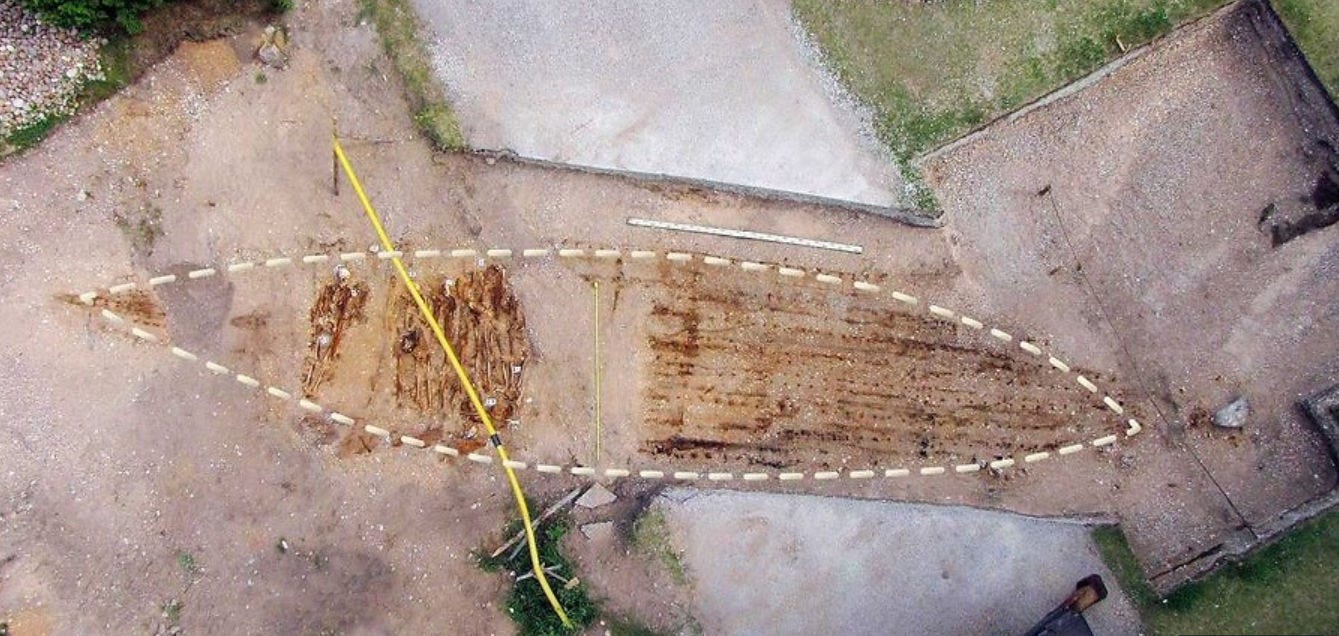When did the Vikings actually start raiding?
Let’s kick things off with a name that already sounds like a metal band: waelwulfas - “slaughter wolves.” That’s what the Old English called them. A nice, cozy nickname for people who would one day burn your monastery, steal your cows, and maybe carry off your favourite deacon.
The Viking Age didn’t explode out of nowhere like some berserker fever dream. It was more like a slow-boiling storm: demographic pressure, local squabbles, ideological shifts, and the kind of social tension that prompts people to pack up their swords and seek opportunities elsewhere. A lot of young men in a silver rush. And when that storm finally broke, it turned Scandinavia into a launching pad for one of history’s most chaotic global franchises. Now, if we’re talking “first contact,” you’ve probably heard of Lindisfarne, 793. That moment is seared into medieval memory like a lightning bolt across the Northumbrian sky - literally, if you believe the sources.
“Here terrible portents came about over the land of Northumbria, and miserably frightened the people: immense flashes of lightning, fiery dragons flying in the air... and a little after that, heathen men raided Lindisfarne and slaughtered everything in sight.”
Anglo-Saxon Chronicle, 793
"In the same year [AD 793] the pagans from the northern regions came with a naval force to Britain like stinging hornets and spread on all sides like fearful wolves, robbed, tore and slaughtered not only beasts of burden, sheep and oxen, but even priests and deacons, and companies of monks and nuns. And they came to the church of Lindisfarne, laid everything waste with grievous plundering, trampled the holy places with polluted steps, dug up the altars and seized all the treasures of the holy church. They killed some of the brothers, took some away with them in fetters, many they drove out, naked and loaded with insults, some they drowned in the sea..."
Simeon of Durham, Historia Regum
What happened there wasn’t just a raid; it was the medieval equivalent of an alien invasion. Lindisfarne was the sacred hotspot of Anglo-Saxon Christianity. Founded in 635 by Aidan, an Irish monk with a holy mission summoned by King Oswald to be the first bishop of Bernicia, it was where sacred relics met monastic peace. That peace didn’t last.
“Never before has such terror appeared in Britain... the church of St. Cuthbert is drenched in the blood of God’s priests.”
Alcuin, writing in sheer panic
The Lindisfarne raid wasn’t just a horror, it was a message. No one was safe any more. Not even monks. Especially not monks.
But was this really the beginning? Well… maybe not. We can consider it a milestone, nonetheless. Backtrack to 789, a few years before Lindisfarne. The Anglo-Saxon Chronicle gives us a cryptic little entry:
"Here Beorhtric [king of Wessex, AD 786-802] took King Offa's daughter Eadburh. And in his days there came for the first time 3 ships; and then the reeve rode there and wanted to compel them to go to the king's town, because he did not know what they were; and they killed him. Those were the first ships of the Danish men which sought out the land of the English race."
And that was it. No dragons, no lightning, no holy terror - just a bloke doing his work and ending up very dead. Some versions of the chronicle say the raiders were from Hordaland, others just call them "Northmen." Honestly, the terminology is a mess. But what it tells us is clear: Scandinavians were already poking around England before Lindisfarne. It’s tempting to read this as a prelude, the teaser trailer for the full Viking saga. But the sources were written with hindsight. By the time monks were copying this down, Viking raids were a full-blown nightmare, and they might have “retrofitted” earlier events to match the tone. Furthermore, most of the chroniclers were interested in whatever the West Saxons were doing about the invaders.
Buckle up because now things get really interesting.
The East Came First: Estonia and the Forgotten Warband
Have you ever heard of Salme, Estonia? Archaeologists digging around the island of Saaremaa made a discovery that rewrites everything we thought we knew about the birth of the Viking Age. Not one, but two boats. Full of Scandinavian warriors. Dead ones.
In the smaller boat: 7 men. In the bigger one: 33. All stacked like cordwood, buried with their weapons, some even with their animals and gaming pieces. The ships date from between 700 and 750: a full half-century before Lindisfarne. They weren’t buried in the grand, solitary boat-grave style you get at places like Sutton Hoo or Gokstad. No. This was hurried. Raw. But still respectful. Shields were placed over bodies. Sails (or cloaks) used to cover the dead. It was a mass grave, but not a chaotic one.
Salme 2, the larger vessel, was about 17 meters long, with a keel and possibly a sail. This wasn’t a fishing boat. This was sea-ready. And that changes everything. This means they had the tech, the organisation, and the intent to go places, maybe get into trouble as well, decades before the "official" start of the Viking Age. Salme 2 may very well be the oldest sailing vessel ever found in the Baltic.
So what happened?
Best guess: a raiding party from the Mälar Valley in Sweden, experienced, armed, and probably related to each other, made their way east to extract tribute, settle a score, or just cause trouble. But they picked the wrong beach. The survivors, whoever they were, took the time to bury their comrades. Like a blanket, shields were placed over the skeletons. Among the bones, fragments of textile were found, maybe pieces of a sail that had been used as a shroud to conceal the dead before sand was added.
And while the grave was rushed, you see details that reveal care: a man with a severed arm has been placed properly, limbs arranged, not just dumped. This isn’t just a one-off. This is part of a pattern, a very early stage of what would become the Viking way of war. We’re seeing the evolution of Vikingdom in real time. Salme is a missing link between the Vendel period and the Viking Age, a shadow cast before the fire. This far East had never produced any boat tombs.
But why the East?
The Baltic was no quiet pond. The Austmarr (Old Norse for the “Eastern Sea”) was a contested, vibrant, and dangerous place. Legendary dynasties like the Ynglingar had activity in the area according to the literary sources. So did their enemies. The Salme site might even connect to the semi-mythical story of Yngvar, a nobleman who supposedly died in Estonia around the 600s.
No high-value targets around? True. But maybe the real target was another warband. Looting wasn’t always about treasure. Sometimes it was about smashing your rivals. Even though the Salme sailing party's members were buried collectively, a wealthy warlord or chieftain and a few well-prepared lieutenants led a band of warriors, as depicted by the weaponry. On Salme 2, for example, five men with double-edged swords and elaborately decorated hilts were buried on top – a clear sign of status. Some bones have signs of old wounds, indicating experienced raiders in the crew as well.
This is the key point: raiding began at home. It started in the east, in familiar waters, before it launched west to Lindisfarne and beyond.
By 795, Ireland was already under Viking pressure. In 808, Frankish sources talk about pirates kidnapping papal envoys. English charters begin to mention fortifications against the pagans. The age of the waelwulfas was coming into full bloom.
So, next time someone says the Viking Age started in 793, feel free to enchant or annoy them with your newly-found knowledge and tell them about Salme.







Tack så mycket för den informationen!
Nice post! There's a Salme exhibit at a museum in Stockholm right now, for anyone in the area: https://www.vrak.se/en/visit-the-museum/exhibitions/vikings-before-vikings/
It's pretty well agreed by scholars that the Brits were familiar with the Scandinavians through trade long before Lindisfarne. There are also recorded attacks by Scandinavian fleets in Merovingian/Frankish lands in the early-6th century, among others. There was a lot of piracy, viking or otherwise all over that part of the world, east and west, but particularly in places like the south Baltic, for centuries before Lindisfarne. Also, we should be cautious about thinking there was a relatively homogenous group of Scandinavians running around here and there, darting around from east to west. The Salme warriors, or those like them from Sweden, very likely had nothing to do with viking warriors in the west, and vice versa. Also, the motives -- other than portable wealth -- were likely as varied as the viking war bands themselves were. And they weren't always successful. The violent injuries of the Salme warriors have led scholars to interpret their situation as a raid that went horribly wrong for them. They were likely on the losing side from the looks of it. There's lots of ongoing research going on right now (my own included!) that is widening the lens on the "Viking Age" by a lot. Stay tuned!